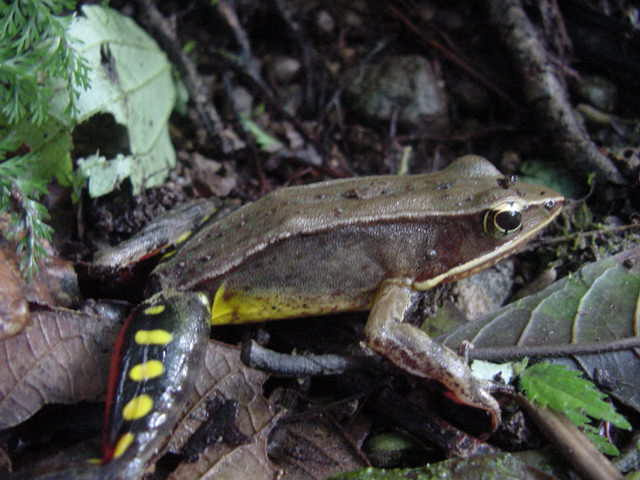Brilliant Forest Frog
Brilliant Forest Frog (Rana warszewitschii) Spanish Name: Rana (No specific common name)

More about Brilliant Forest Frog
Habitat
As its name suggests, this frog lives in forests near ponds, small streams, or other slow-moving water. Within its habitats it is commonly found wherever there are portions of forest, even within cities. It can survive in gallery forest, lowland dry, moist, and wet forests, premontane moist and wet forests, and rainforest into lower montane wet forest and rainforest.
Range
This frog can be found from Honduras and Nicaragua to Costa Rica and Panama.
Physical Description
The smooth-skinned Brilliant Forest Frog is elegantly slender with smooth skin, a pointed head, longish snout, and big golden eyes. Unlike some frogs, its ears are clearly visible. This bronze species is spotted with vibrant blue or green and has brilliant red on the underside of its limbs and on the webs between its toes. It may have a few bright yellow splotches on the back of the thigh. The sides of the body are darker, the belly cream to grey, and on some males almost black. The face is masked in black, with a pale stripe from the snout to the eye, a white stripe on the upper lip, and a skin fold extending from the eye to the groin.
Biology and Natural History
These moderately sized frogs may be heard calling softly during the day from the forest floor in a slow, low trill.
Younger individuals may also be active at night, but adults are generally active during the day, scooting around on the forest floor. Their coloration camouflages them well while sitting still; but when startled, they leap into the air and then dive under leaf litter. This frog is muscular and long-legged; with bright colors hidden on the underside and inside of limbs, when this creature unexpectedly leaps, it uses a defense called flash-and-dazzle, as the confusing color scheme of the creature changes with its movement. After extending long, bright limbs mid-leap, the colors disappear again when the frog lands and buries itself in leaves.
The Brilliant Forest Frog has expanded toe and fingertips to help it climb, but does not have the sticky discs found on tree frogs. This frog has webbing on its feet but not its hands, and is less of a swimmer than some of its relatives.
It reproduces all year, and attaches its eggs to the underside of rocks. In its young stage of tadpole, most of its length is comprised of tail, which disappears as it develops into an adult frog.
Diet
The Brilliant Forest Frog eats small arthropods that it finds among the leaf litter.
Height/Weight
Adult females, at 45-63 mm (2.5 in), are usually larger than their male counterparts, which grow to 37-52 mm (1 7/8 in). Tadpoles can be as long as 115 mm (4.5 in).
Taxonomy
Order: Anura
Family: Ranidae
Source
Leenders, Twan. A Guide to Amphibians and Reptiles of Costa Rica. Zona Tropical, S.A, Miami, FL, 2001.
Savage, Jay M. The Amphibians and Reptiles of Costa Rica: A Herpetofauna between two Continents, between Two Seas. The University of Chicago Press, Chicago, 2002.
-Amy Strieter, Wildlife Writer
Brilliant Forest Frog Sightings
Similar Profiles
We believe travel is more than ticking destinations off a list – it’s about discovering new places deeply, feeling connected wherever you go, and knowing you have a trusted team behind you every step of the way.



